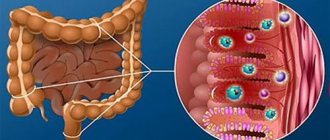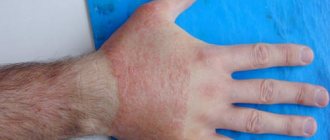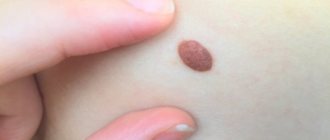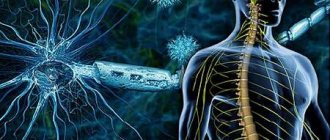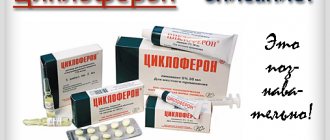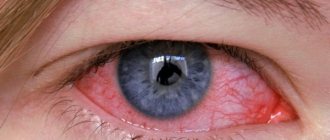Author of the article
Anatoly Shishigin
Reading time: 4 minutes
AA
Acetone, which is excreted from the body in urine, is toxic. Ketone bodies are produced by body systems due to the partial breakdown of protein formations. The process is called acetonuria.
Normal levels are 20...50 mg per 24 hours, but clinical medicine indicates the absence of these substances in the body when a person is healthy. A particular danger of acetone release is the rapid development of pathology and threat to the patient’s life. Pulmonary and cardiac activity is impaired, the brain swells, and death is possible.
Reasons for the formation of ketone cells
Acetone in the urine in large volumes in children, adults and pregnant women is formed due to an excess of ketone bodies in the blood, otherwise - acetonuria. Ketones occur during the production of glucose with the participation of fats and proteins. Glucose provides energy to humans. Due to lack of energy, acetone begins to be released into the urine. Hence, a person develops a specific smell of acetone from his mouth. The body begins to break down its own fats and proteins.
Ketones have a destructive effect on the cells of the body; under their influence, the gastric mucosa is irritated; due to their presence, metabolic acidosis can develop, which can lead to a person’s state of coma. These bodies in the blood have a negative effect on the central nervous system.
The causes of excess ketones in the body in children and adults are:
- eating large amounts of fats and animal proteins;
- physical stress;
- stress, overexcitement;
- lack of carbohydrates in food; diabetes.
The main causes in children are poor nutrition and malnutrition. In children, the stomach is not yet able to quickly and well digest fatty foods, so vomiting, which smells like acetone, can occur even after a single large-volume intake of very fatty foods.
When undernourished, the body begins to process its own fat, and at the same time ketones enter the blood, they are the cause of acetonuria. Children with this diagnosis are excitable, hyperactive, well mentally developed, and very often underweight. With this disease, there is an increased level of uric acid in the blood, which in the future contributes to the development of gout, joint disease, and diabetes. Usually it persists in children until they reach puberty (13-14 years old), after which the disease mostly goes away.
In pregnant women, the increased content occurs due to the fact that the women’s body does not have time to adapt to the changes occurring in their body. If pregnant women continue to have elevated levels of acetone after the 20th week of pregnancy, this can cause serious consequences. But basically, for most women, these symptoms disappear in the first half of pregnancy.
Diagnostic measures
When urine smells like acetone in men or women, laboratory and instrumental examinations are performed. Be sure to check the condition of your urine and blood - either at the clinic or using test strips at home.
Outpatient settings are preferable because they identify not only the presence of ketones, but also their ratio. Test strips only reveal the presence of acetone and its approximate volume. Each of the studies presented is carried out in the morning - the first portion of urine is studied. As instrumental methods, ultrasound of the peritoneal organs is performed. If there are suspicions of other pathologies or treatment at the initial stage was ineffective, additional examinations are carried out - CT, MRI, tests for tumor markers.
Symptoms of the presence of ketone cells
With acetonomia, children begin to refuse food and complain of abdominal pain. He develops constant vomiting after eating, severe drowsiness, lethargy or fainting appears, which can later lead to a coma.
The child has the smell of acetone from the mouth and secreted fluid, dehydration of the body, dry skin, and increased body temperature occur.
Children are diagnosed with “acetonemic syndrome” if such conditions occur several times during the year.
These symptoms can be identified independently, but only a doctor can diagnose and find out the causes of the disease using detailed tests.
Diagnosis of the presence of acetone in urine
You can detect acetone in urine yourself using test strips. Test strips are sold freely in pharmacy chains. You should also pay attention to whether the smell of acetone comes from your mouth.
To do the test, you need to place the test strip in a container of urine for a few seconds.
If after two minutes the color of the strip has not changed, it means that there are no processes in the body to produce acetone.
If the color of the strip turns pink, the acetone content is not high; the red tint of the strip means clearly expressed acetonuria.
The test will show one of the following results:
- +0.5 mmol/l - mild degree, treatment can be carried out independently;
- ++4-10 mmol/l – average degree, it is necessary to take prompt measures for recovery, and if the condition worsens, seek help from the hospital;
- +++more than 10 mmol/l – severe, urgent hospitalization is required.
After determining a large amount of acetone in the child’s urine, in order to find out its causes, it is necessary to do an ultrasound of the liver, since in this condition it increases in size. You also need to take tests: a biochemical blood test and a general urine test. There will be a low concentration of glucose in the blood, and a high number of leukocytes and ESR. Urine analysis shows a high level of acetone.
How to determine the presence of a pathological process in urine
The quantity, physical and chemical characteristics of the final metabolic product secreted by the kidneys, even in a practically healthy person, depend on many factors that are taken into account in laboratory tests of urine
You can assume that something is wrong with your health on your own; to do this, it is enough to pay attention to the main characteristic of urine - the smell. Normally, it is barely perceptible; a specific amber can be imparted by substances present in urine that are formed during the development of pathological processes in the body
An acetone odor, reminiscent of the aroma of sour apples, appears when the amount of ketone bodies excreted from the body daily - β-hydroxybutyrate and aceto-acetate, which are formed in the liver - is exceeded in the urine.
Normally, it is barely perceptible; a specific amber can be imparted by substances present in urine that are formed during the development of pathological processes in the body. An acetone odor, reminiscent of the aroma of sour apples, appears when the amount of ketone bodies excreted from the body daily - β-hydroxybutyrate and aceto-acetate, which are formed in the liver - is exceeded in the urine.
This phenomenon may be associated with poor nutrition, changes in water-salt balance, or the development of acetone syndrome, which requires immediate treatment.
The formation and composition of urine depends on the amount of fluid drunk and the functioning of the urinary system, as well as nutritional, psycho-emotional and physical stress that the human body receives
Treatment of acetonuria
After confirming the diagnosis, in order to avoid the development of consequences, treatment should be started as early as possible. It is better for children and pregnant women to undergo treatment in a hospital. Sometimes, with “acetonomy syndrome”, if the child has already been diagnosed with it, experienced parents can provide assistance on their own. However, if this happens to a child for the first time, you should definitely consult a doctor to determine the course of treatment, since the body’s behavior towards acetone vomiting can be unpredictable. The doctor will prescribe further competent treatment; in general, hospitalization is not required if the child’s condition resolves without severe complications.
The main goal of treatment is to eliminate acetone in the urine of children or pregnant women and increase glucose levels. You can prevent intoxication of the body with an enema. In this case, it is necessary to drink a medicine based on enterosorbents (entrosgel, smecta, etc.), provide the child with plenty of fluids up to 1.5 liters per day. You need to drink often and in small portions. In case of severe vomiting, you can give water using a pipette in the form of drops. To increase the level of glucose in the blood, you need to alternate the water with sweet tea or compote; it is also recommended to give Regidron saline solution.
Since the child has a decreased appetite during this period, under no circumstances should he be forced to eat, but at the same time, he should not be allowed to starve. You need to give light food - low-fat soup with breadcrumbs or high-carbohydrate porridge with water. If he continues to feel unwell, in a hospital setting he will be provided with intravenous fluids, this will help completely remove ketone bodies from the body. As a rule, with proper treatment, symptoms go away within 3-5 days.
After the symptoms of acetonuria have been eliminated, it is necessary to prevent its reoccurrence. To do this, you need to pass all the necessary tests, follow a proper diet and lead a healthy lifestyle.
Children are recommended to get regular sleep, prolonged exposure to air, and moderate physical activity. Children should be limited in watching cartoons and playing games on the computer. Make sure he doesn't get overtired.
What does ketone content in urine mean?
An increase in acetone content compared to the norm is called acetonuria or ketonuria. Particularly characteristic of acetonuria is the excretion of ketone bodies in the urine, these include acetoacetic acid, hydroxybutyric acid and acetone itself.
From a practical point of view, each indicator is not analyzed separately, but such a generally accepted concept as “acetone” is used. It is formed through insufficient oxidation of proteins and fats by the human body, and in high concentrations it is toxic.
Exceeding the rate of ketone formation before their oxidation and elimination is fraught with such consequences as:
- dehydration;
- damage to the gastrointestinal mucosa;
- increased blood acidity;
- damage to brain cells up to swelling;
- cardiovascular failure;
- ketoacidotic coma.
Diet for acetonuria
First of all, it is necessary to exclude foods containing ketone bodies from your diet. The diet promotes normal carbohydrate metabolism. A balanced diet will help stabilize the condition and avoid relapses.
You should avoid foods such as: meat, fatty soups, spicy foods, all products containing coffee and cocoa, sour cream, oranges. Avoid drinking carbonated sweet water, chips, fast food and other unhealthy foods containing preservatives. And vice versa, eat more fruits, hard biscuits, foods rich in carbohydrates - buckwheat, pearl barley, beans, fermented milk products.
The patient’s speedy recovery depends on proper nutrition, so special attention should be paid to it.
Prevention of the appearance of acetone in urine
To avoid recurrence of the disease in the future, you need to lead an active healthy lifestyle.
- Long walks, preferably combined with sports. Physical activity leads to normalization of the metabolism of fats and carbohydrates; the main thing in this matter is not to overexert yourself.
- It is recommended to include water procedures in the daily routine; they improve metabolism and strengthen the baby.
- A child needs full sleep (8-9 hours), and preschoolers also need a nap during the day.
- It is recommended to avoid prolonged exposure to the sun.
- It is necessary to limit TV shows and computer games.
- It is necessary to constantly monitor his health and protect him from infections. Get all required vaccinations.
- Constantly maintain your diet. Give food in small portions without a long break between meals.
- Take vitamins periodically twice a year.
- If the baby is hyperactive with an unbalanced nervous system, he is prescribed sedatives (valerian, motherwort, massages).
If you smell acetone on your child’s breath, it is recommended to do a test to determine its content in the urine; for this, be sure to have test strips in the house to independently detect acetone in the urine in case of suspicious symptoms.
Children and adults with attacks of acetone vomiting are at risk of developing diabetes mellitus, so they need to be monitored by an endocrinologist.

